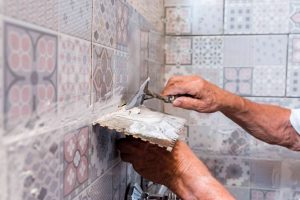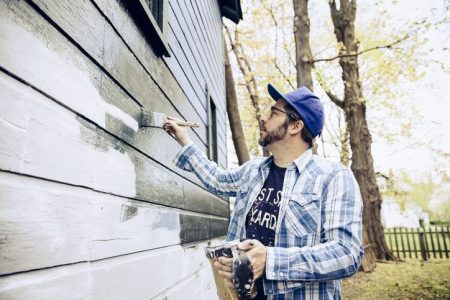A concrete vibrator is a tool that makes stronger concrete by vigorously shaking the concrete right after you pour it to eliminate the air bubbles or air pockets. Air pockets substantially weaken a concrete structure. Vibrating is critical when working with concrete on commercial sites, road projects, walls, driveways, curbs, gutters, and construction joints.
What Is a Concrete Vibrator?
A concrete vibrator is a machine that comes in several different shapes and sizes. Some are small, hand-held, and run strictly on battery power, while others require an electric plug. The device usually has a head, shaft, and vibrating motor. The shaft is inserted vertically into the concrete for about 15 seconds to push air bubbles to the surface.
Why You Should Use a Concrete Vibrator
When pouring concrete, it might have hundreds or even thousands of air bubbles, which can substantially weaken the concrete structure. Concrete vibrators eliminate air bubbles by vigorously shaking the freshly poured concrete. Using a concrete vibrator during a pour is not only recommended, but, in many cases, it is also a building code requirement.
Types of Concrete Vibrators and How They Work
Concrete vibrators come in different forms and can be electric or air-driven. Applications for concrete vibration can be grouped into three basic categories:
- Formwork vibration: Formwork vibration is commonly used in precast concrete construction and involves mounting the vibrators to the outsides of the concrete forms. For larger pours, the external form vibrators are often spaced 6 feet apart.
- Surface vibration: With surface vibration, large vibrators (sometimes called “jumpers”) are directed manually onto the surface of the poured concrete. This method is limited to a concrete slab depth of about 6 inches or less, but it provides a smooth surface that is especially desirable when appearance is important.
- Internal vibration: Internal concrete vibrators are the most common type used. A single operator can handle it. The process is relatively simple: The worker quickly jams a probe-like internal vibrator into the wet concrete, then slowly withdraws it.
Tips for Using a Concrete Vibrator
How Long to Vibrate Concrete?
Most concrete is under-vibrated or improperly vibrated. The best technique with an internal vibrator is to withdraw the vibrator very slowly, at a rate of around 1 inch per second. As long as bubbles still emerge as the concrete vibrator is removed, more vibration is necessary.
Contractors sometimes urge workers to complete this time-consuming task “efficiently,” meaning quickly, but the result can be a structural failure after the concrete cures. At the same time, if you hold the vibrator in the concrete for too long, the water and aggregates will separate, creating problems with the strength and aesthetics of the concrete.
Be Ready Before You Pour
Proper vibration takes skill and experience. Keep a spare concrete vibrator ready as a backup in case the first vibrator fails. The concrete won’t wait for you to sort out equipment problems. Insert the vibrator in a vertical or nearly vertical position to maximize its effect.
Also, do not bend a vibrator excessively, which can ruin it. Avoid the common mistake of using a vibrator as a concrete placement tool. This can create an inconsistent surface and other problems.
Follow the Proper Usage Steps
Verify that other co-workers have not vibrated the specific concrete areas before proceeding with vibration. Submerge the vibrator head fully into the concrete and hold it there for at least 10 seconds. Don’t turn on the vibrator until the tip is fully submerged.
Pull up the vibrator at an average rate of no more than 3 inches per second; often, 1 inch per second yields the best results. Overlap the previous radius of vibration every time you insert the vibrator. A good rule of thumb is that the radius of action is four times the vibrator tip diameter. Stop vibration when air no longer escapes from the concrete and the concrete surface develops a sheen.
Prevent Cold Joints
Do not force the vibrator into the concrete; it can be caught by rebar, the reinforcing steel. Be sure to penetrate previous lifts or layers of concrete already placed to prevent cold joints. The vibrator should penetrate at least 6 inches into the previous layer.
A cold joint occurs when the newer layer of concrete is poured on an older layer that has been set up and hardened enough to prevent the two layers from bonding.
Don’t Under-Vibrate
Be careful not to under-vibrate low-slump concrete. “Slump” is a measure of the workability of concrete. Because low-slump concrete is stiffer, it requires more vibration. Consider using a lightweight, portable vibrator for small jobs. You can also eliminate the need for vibration by using self-consolidating concrete if desired.
-
What can I use instead of vibrating concrete?
A bladeless sawzall or an orbital sander turned on and held against the concrete form will vibrate and remove air voids.
-
Does vibrating concrete make it stronger?
Vibrating concrete increases the density and strength of the concrete, making it more durable.
-
What will happen if concrete is not well vibrated?
If not well vibrated, concrete will develop voids, called honeycombing, weakening its structural integrity.
Read the full article here














